Have you ever noticed how your mind feels cluttered after hours of scrolling, replying, and multitasking online? In today’s distraction-filled world, it is essential to learn how to pause and breathe digitally.
A digital detox is presented not as a rejection of technology but to retrain the brain for intentional engagement, akin to decluttering the mind to foster focus and genuine connections.
NIH reports that a two-week digital detox from social media, restricting usage to 30 minutes daily, significantly improved smartphone addiction, sleep quality, life satisfaction, stress levels, perceived wellness, and supportive relationships among young adults.
Benefits extend to adopting mindful habits, reducing mental fatigue, and enhancing concentration. Consistent practice can improve sleep patterns and strengthen relationships, promoting personal growth and professional excellence.
In this guide, you will discover the transformative effects of a digital detox on mental clarity, emotional balance, and cognitive renewal. It aims to provide practical strategies, encouraging a purposeful life amid distractions.
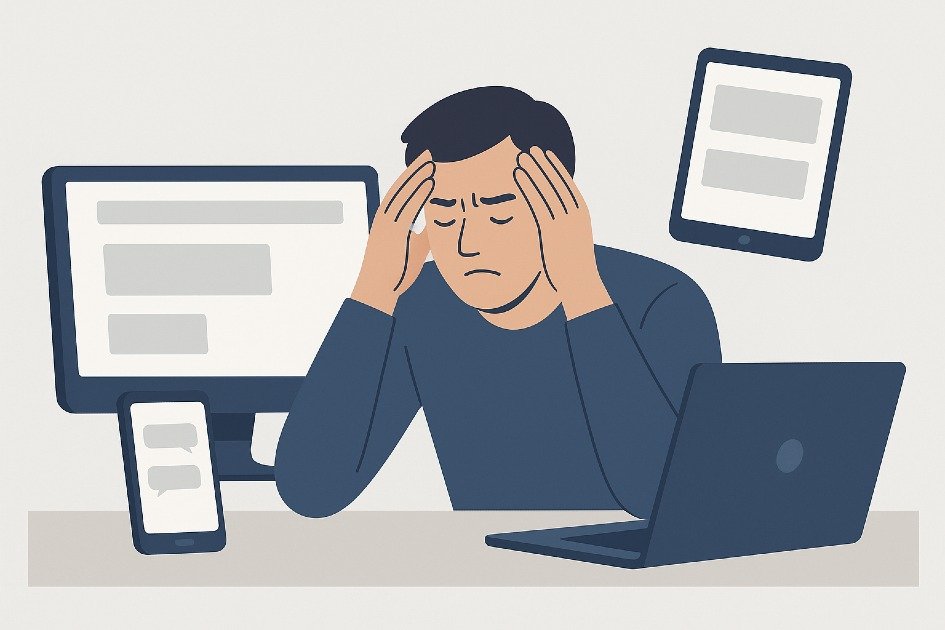
Too Much Screen Time Hurts Focus
Mental fatigue has become commonplace due to relentless notifications, social media, and constant emails.
This influx affects not just productivity but also mood, sleep, and mental well-being. Recognizing digital overload is crucial for effectively undertaking a digital detox.
How Constant Connectivity Impacts Mental Health
Constant online connectivity alters brain function by maintaining heightened alertness from frequent email and message checks, increasing stress hormones, hindering concentration, and potentially leading to anxiety.
How to improve:
- Limit email checks to fixed times. For example, open your inbox twice a day instead of constantly refreshing. This keeps you focused and saves time.
- Try the Pomodoro method: work with focus for 25 minutes, then rest your eyes and mind with a 5-minute screen-free break.
- Spend 2–3 minutes on deep breathing. It relaxes your mind and sharpens focus fast.
When I turned off most of my phone notifications, I felt calm right away. Soon, my thoughts became clearer, and I paid more attention to my surroundings. Cutting alerts was an easy step in my digital detox.
How Social Media Drains Your Mind
Social media can undermine attention and self-esteem by creating compulsive habits through endless scrolling and dopamine bursts.
Constant notifications fragment focus, leading to irritability, decision fatigue, and reduced personal control over time.
How to improve:
- Silence non-essential alerts. Keep only important calls or texts from family.
- Use your phone’s screen time tools or a digital wellbeing app to track and limit how long you spend on apps.
- Take short breaks from social media, like during meals or right after you wake up. These quiet moments help your mind stay calm and focused.
I turned off Instagram notifications in the evenings and felt my anxiety drop. Without constant pings, I could read and journal, giving my mind a calm reset. These tech-free moments became a simple, powerful part of my digital detox.
Signs You Might Be Experiencing Digital Burnout
Spotting the signs of digital burnout early protects your focus and well-being. Common indicators include:
- Chronic fatigue or brain fog
- Difficulty concentrating
- Increased irritability or mood swings
- Trouble sleeping
- Constant urge to check devices
How to improve:
- Try a mini digital detox: start with one tech-free evening each week and slowly extend the time.
- Swap screen time for mindful hobbies like reading, sketching, or nature walks.
- Track your moods daily in a journal to boost mental clarity and spot patterns.
I log off for a few hours each day, and just 30 minutes of screen-free time has improved my focus and sleep. Digital detox really works.
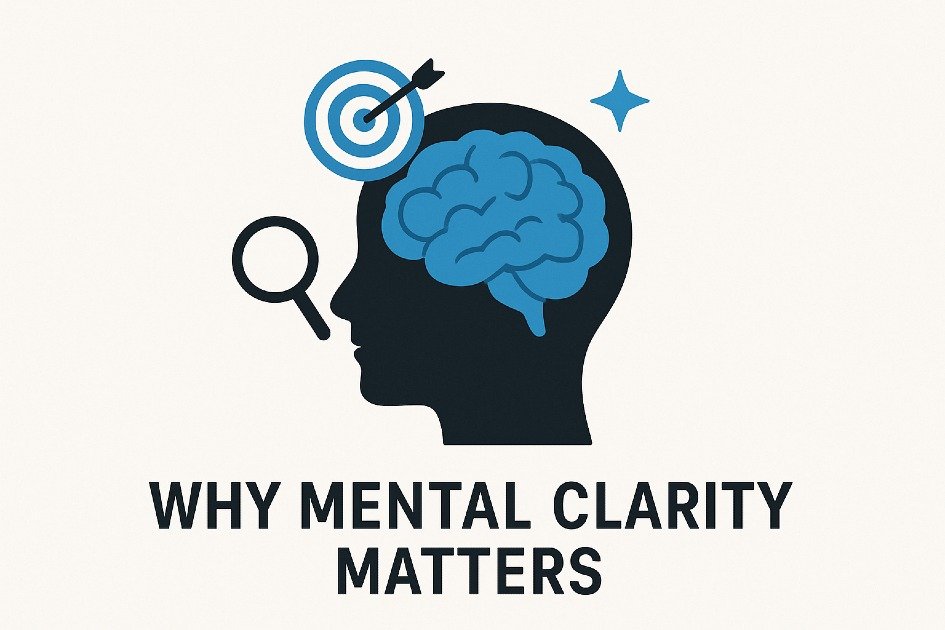
Why Mental Clarity Matters
Maintaining mental clarity is essential for well-being in a screen-dominated world.
Distractions like notifications and scrolling diminish focus, leading to cognitive fatigue.
A digital detox is necessary for restoring cognitive balance, enhancing emotional resilience, and increasing productivity.
The Science Behind a Clear and Focused Mind
Your brain functions best with patterns, rhythm, and rest.
Frequent switching between apps and tasks leads to cognitive fatigue. Research indicates that multitasking can decrease efficiency by 40% and heighten mental exhaustion.
How to improve:
- Take a short break every hour and close tabs you do not need.
- Practice 5-minute guided meditations to focus your mind and stay present.
- Focus on one task at a time. Turn off digital distractions and give your full attention to what you are doing.
During my digital detox, focusing on one task at a time turned hectic mornings into calm, productive hours. Even checking emails became easier and less tiring.
Digital Overload Steals Your Rest and Focus
Excessive screen time disrupts the brain’s circadian rhythm due to blue light exposure, leading to difficulties in falling asleep and reduced deep sleep cycles. This poor sleep can negatively affect focus, creativity, and emotional stability.
Additionally, constant social media engagement can cause anxiety, fear of missing out (FOMO), and mental fatigue.
How to improve:
- Set a digital curfew an hour before bed. Swap phone time for reading or journaling.
- Wear blue-light glasses or use filtering apps to protect your eyes during evening screen time.
- Record your mood and energy daily to spot patterns and track progress.
When I started a nightly digital detox, I felt my focus sharpen at work and my mood improve. Mornings were clear and calm, free from the fog of endless scrolling.
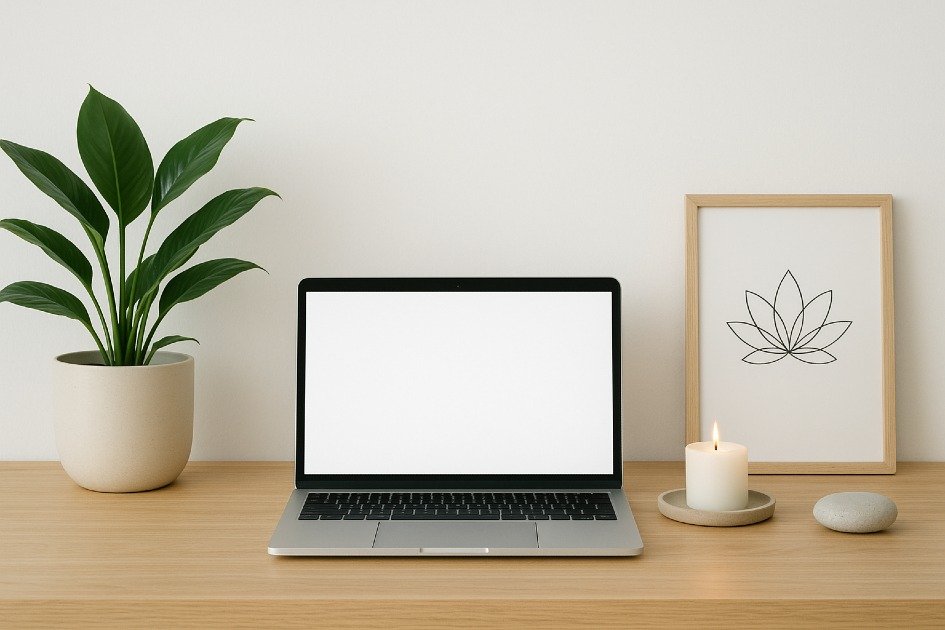
Setting the Stage for a Digital Detox
A successful digital detox requires preparation, intention, and awareness of your digital habits. By establishing a foundation beforehand, the process becomes realistic, achievable, and rewarding.
Identifying Your Digital Triggers
Why it matters:
Many individuals unconsciously engage with social media and notifications, impacting their mental clarity. Recognizing triggers associated with overuse is essential for achieving an effective digital detox.
How to do it:
- Track your device use for a week. Note the time, place, and reason you pick up your phone or computer.
- Notice what sparks your feelings—like boredom, worry, or feeling alone.
- Identify apps and notifications that distract you from work or real-life moments.
- Sort your triggers into high, medium, and low priority to target your detox effectively.
I use a screen-time tracker to spot habits I do not even realize I have.
Assessing Your Current Screen Time Habits
Why it matters:
Awareness of actual screen time is crucial for understanding digital habits, allowing for informed adjustments during a digital detox, which can otherwise feel arbitrary or overwhelming.
How to do it:
- Use your phone’s built-in screen time or digital wellbeing tools to track and manage device use.
- Track which apps or devices consume your time.
- Monitor wasted hours and focus on tasks that truly matter.
- Think about how screens affect your sleep, focus, and stress.
I cut my pointless scrolling by almost 25% just by tracking my screen time for a week.
Creating a Realistic Digital Detox Plan
Why it matters:
A digital detox is unsuccessful if excessively extreme or unrealistic. Effective planning allows you to uphold commitments without increasing stress, turning the detox from a vague concept into a feasible strategy.
How to do it:
- Set clear detox goals, like cutting social media in half or turning off screens after 8 PM.
- “Make tiny changes step by step instead of quitting all at once.
- Set daily digital-free times, such as during breakfast, morning routines, or walks.
- Share your plan with friends, family, or coworkers to set clear expectations and get support.
- Replace idle time with reading, journaling, or hobbies you enjoy.
When I combine a digital detox with mindfulness exercises, I clear my mind twice as fast and feel focus throughout the day.
Preparing Your Environment
Why it matters:
Your environment can either support or obstruct your digital habits; by modifying it, you can minimize device temptation and promote healthier behaviors.
How to do it:
- Set phone-free zones, like your bedroom or dining table, to boost focus and rest.
- Mute non-essential alerts to stay focused and reduce distractions.
- Arrange your desk to highlight notebooks and planners over digital devices.
- Place your phone in another room while working or relaxing to focus better and reduce stress.
I move my phone to another room at night, and I sleep deeper and think clearer the next day.
Building Accountability and Support
Why it matters:
Doing it alone can lead to reverting to old habits, while accountability and social support enhance consistency and make the digital detox more enjoyable.
How to do it:
- Connect with online or local groups that promote healthy tech use.
- Try a detox challenge with a friend or family member. Support each other, stay motivated, and make healthy habits stick.
- Check your progress each week, recording wins and obstacles.
- Reward yourself for small wins to stay motivated and build lasting habits.
When I share my progress in a private group, I stick to 40% more goals.

Morning Rituals for a Screen-Free Start
Starting your day without immediately using your phone can enhance mental clarity and focus.
Morning rituals can facilitate a digital detox, reduce stress, and promote an intentional mindset.
Practical steps to achieve this are both simple and significantly beneficial.
Start Your Day with Mindfulness Instead of Emails
Why it matters:
Jumping into emails or notifications first thing increases stress and creates a reactive mindset.
Conversely, morning mindfulness improves focus, emotional stability, and mental clarity, fostering a calmer and more intentional day.
How to do it:
- Begin with a 5-minute meditation: To achieve mindfulness, sit quietly, focus on your breath, and observe your thoughts without judgment.
- Use a guided meditation app: Use mindful.org only after your first mindfulness practice, not right when you wake.
- Reflect on three things you are grateful for: This sharpens your mind for clear, positive thinking.
- Wait at least 30 minutes after waking before checking your phone to start your day focused and calm.
The Power of Journaling and Reflection Before Screens
Why it matters:
Journaling helps organize thoughts and reduce cognitive clutter caused by digital engagement, while reflection aids in identifying priorities and focusing on what truly matters rather than reacting to notifications.
How to do it:
- Place a notebook by your bed to jot down morning thoughts and set your day’s intentions.
- List your daily goals, keeping them simple and doable.
- Record your mood and thoughts each day to spot stress or focus patterns.
- Ask yourself: ‘What matters most today?’ or ‘How can I make today count?
Simple Exercises to Energize Your Body and Mind
Why this matters:
Morning physical activity improves blood circulation, boosts endorphins, and enhances cognitive function, helping to reduce digital fatigue and increase focus for the day ahead.
How to do it:
- Stretch 5–10 minutes to activate muscles and loosen joints.
- Do gentle yoga or tai chi to balance your mind and body.
- Boost energy with quick exercises like jumping jacks, squats, or a brisk walk outdoors.
- Start your day with energizing music instead of scrolling. Use Spotify playlists for a screen-free, motivating morning boost.
Hydrate and Nourish Before Digital Exposure
Why it matters:
Dehydration and low energy can lead to irritability and decreased focus, increasing susceptibility to digital distractions.
A mindful approach to nutrition can improve mental clarity during a digital detox.
How to do it:
- Start your day with a glass of water to wake up your body and boost hydration.
- Start your day with breakfast that combines protein, whole grains, and healthy fats.
- Put your phone down and taste each bite—eat mindfully to stay present.
- Prep a smoothie or oatmeal tonight for an easy, stress-free morning.
Creating a Purposeful Morning Environment
Why it matters:
Your environment influences your habits; a cluttered or technology-laden space promotes mindless scrolling, while a serene, deliberate space supports your dedication to a digital detox.
How to do it:
- Place devices out of reach in the morning to start your day focused and calm.
- Let sunlight in or open windows to wake your mind and stay alert.
- Listen to calming music or nature sounds instead of scrolling notifications.
- Add plants or soothing visuals to make your space calm and relaxing.
Incorporate Mindful Reading or Learning
Why it matters:
Reading in the morning enhances mental stimulation without digital distractions, fostering focus and a more deliberate learning pace.
How to do it:
- Add plants or soothing visuals to make your space calm and relaxing.
- Read inspiring or educational content for 10–15 minutes daily to boost your knowledge and mindset.
- Jot key points to boost understanding and memory.
Set Intentions for a Screen-Free Morning Routine
Why this matters:
Establishing clear intentions helps reduce mindless scrolling and encourages a digital detox. Intentional mornings contribute to enhanced focus and lower stress levels throughout the day.
How to do it:
- Set a tech-free morning period, like the first hour after waking, to start your day calm and focused.
- Pick your top three morning tasks and focus on them first.
- Place sticky notes or set alarms (avoid phone alerts) to stay focused.
- Celebrate your morning wins to strengthen good habits.
I start my mornings with simple rituals that give my day a calm, focused boost. By stepping away from screens, I clear my mind, lower stress, and tackle tasks with more focus and purpose. Even a few quiet minutes make my day feel manageable and intentional.

Simple Ways to Recharge at Noon
Midday is a peak time for digital fatigue, caused by constant notifications and social media use, which can lead to mental and emotional exhaustion.
To combat this, structured digital detox strategies can help restore focus, boost productivity, and enhance well-being. Making afternoons screen-free is a recommended approach.
Taking Intentional Breaks from Technology
Why it matters:
Extended screen time can overwhelm cognitive processing, leading to reduced focus, increased stress, and diminished creativity.
Taking short, intentional breaks can help restore mental clarity and alleviate digital fatigue.
How to do it:
- Take a 5–10-minute break each hour to clear your mind and boost focus.
- Set a timer or reminder app to take regular breaks stress-free.
- Shut extra tabs and mute alerts to keep your space distraction-free.
- Practice mindful breathing by breathing in four counts, holding for four, breathing out for six.
When I step away from screens, even for a brief time, I get more done. I answer emails faster, and fresh ideas come to me with less effort.
Nature Walks and Movement to Reset Your Brain
Why it matters:
Sitting for lengthy periods can impair blood circulation and cause eye strain. Engaging in movement enhances oxygen flow to the brain, alleviates stress, and fosters mental clarity, which is especially important during a digital detox.
How to do it:
- Step outside and walk for 10–20 minutes, even if it is only around your block.
- Take it, see the sun, feel the wind, hear the birds.
- Do quick shoulders and neck stretches at your desk to ease tension and stay relaxed.
- Use a pedometer or fitness tracker to stay consistent, but do not stress over the numbers.
After lunch, I use this approach to recharge my mind and lift my mood. It helps me stay focused and makes the rest of my tasks feel easier.
Mindful Eating Without Digital Distractions
Why it matters:
Lunchtime distractions from screens, such as social media and emails, hinder nutrient absorption, promote overeating, and impair digestion. Engaging in mindfulness, screen-free meals can enhance mental clarity.
How to do it:
- Choose a calm spot to eat, not your desk. This helps you enjoy food, reduce stress, and improve digestion.
- Notice the color, feel the texture, and breathe in the smell of each bite to stay present.
- Put your phone and computer away during meals. Keep devices in another room so you can enjoy your food and focus on the people with you.
- Set a digital timer to remind you when your meal is over and it is time to move on to your next task.
When I eat mindfully without screens, my energy stays steady, my focus sharpens, and my digital detox feels stronger all afternoon.
Short Meditation or Mindfulness Sessions
Why it matters:
Mental clutter arises from constant digital engagement; brief meditation can reset the mind, reduce stress hormones, and improve focus.
Integrating mindfulness into the midday routine helps combat digital fatigue in the afternoon.
How to do it:
- Take 5–10 minutes to sit in a calm spot and focus on your breath or a short meditation.
- Pay attention to your breath or how your body feels. Notice distractions, but do not judge them—just bring your focus back.
- Try a guided meditation platform to lead your first mindfulness session.
- Pair meditation with gentle stretches or yoga to relax your body and calm your mind.
I use this practice to boost my energy, stay calm, and focus clearly on every task ahead.
Scheduling Mini Digital Detox Moments
Why it matters:
Unstructured time can result in mindless scrolling and constant notifications. By pre-scheduling tech-free periods in your midday routine, you can disrupt this dependency and regain control over your attention.
How to do it:
- Set 30–60-minute blocks in your calendar for focused work or offline time.
- Tell colleagues or friends when you will be offline, so they do not expect quick replies.
- Pair these blocks with creative or reflective activities like journaling, sketching, or reading.
- Use apps that block distracting sites to boost your focus.
I stick to set offline times, and it helps me keep my digital detox habits, lowers my stress, and makes me feel happier.

Evening Habits for a Peaceful Mind
Creating a calm and restorative evening routine is vital for mental clarity, particularly in a hyper-connected world. It can improve sleep quality, decrease stress, and prepare the mind for the next day.
Simple digital detox strategies before bed can help regain control over attention and emotional well-being.
Establishing a Digital Curfew
Why it matters:
Constant notifications and screen time hinder relaxation and sleep by affecting melatonin production.
Implementing a digital curfew can help reduce anxiety and improve sleep quality.
How to do it:
- Turn off all screens 60–90 minutes before bed to help your mind and body relax for better sleep.
- Silence distractions by turning off push notifications or enabling “Do Not Disturb” mode.
- Keep your devices out of the bedroom to avoid late-night distractions.
- Cut screen time by 15 minutes at a time to make digital breaks easier.
I wear blue light glasses in the evening to ease eye strain and help me sleep better.
Replacing Screen Time with Relaxation Techniques
Why it matters:
Screen exposure activates the sympathetic nervous system, hindering relaxation.
In contrast, relaxation rituals signal the body to rest, lowering cortisol levels and alleviating mental clutter.
How to do it:
- Breathe mindfully: Inhale for four, hold four, exhale six. Do this 5–10 times to calm your mind and body.
- Use progressive muscle relaxation to tense and release each muscle from head to toe.
- Do gentle stretches or yoga to ease daily tension and relax your body.
- Play calming sounds, like meditation podcasts or soft instrumentals, to relax your mind and put yourself in a peaceful mood.
Journaling for Mental Release
Why it matters:
Mental clutter can disrupt sleep, while writing down thoughts helps clarify and reduce rumination.
Journaling promotes reflection, intention-setting, and emotional decompression, leading to improved sleep and emotional balance.
How to do it:
- Place a notebook by your bed and spend 5–10 minutes reflecting each night.
- Jot down your worries, wins, and tomorrow’s tasks to clear your mind and boost focus
- Write three things you are thankful for daily to lift your mood and spark positivity.
- Try asking simple prompts: “What should I release tonight?” or “What gave me energy today?”
Creating a Calm, Tech-Free Environment
Why it matters:
Environmental cues can influence the speed of your body’s transition into rest mode, with a calm, tech-free environment enhancing mental clarity and sleep quality.
How to do it:
- Lower lights or switch to warm, soft lighting 30 minutes before sleep to signal your body it is bedtime.
- Keep TVs, smartphones, and laptops out of your bedroom to sleep better and reduce stress.
- Use soothing scents like lavender candles, essential oils, or diffusers to create a calm, relaxing space.
- Keep your bedroom organized; clutter strains your mind and blocks restful sleep.
Practicing Digital Minimalism Before Sleep
Why it matters:
Mindless scrolling increases stress and comparison, resulting in overthinking.
Digital minimalism encourages intentional technology use, aiding in reclaiming personal time and enhancing mental clarity.
How to do it:
- Set specific times for social media and finish use before evening.
- Stop unnecessary emails and notifications that clutter your mind.
- Swap endless screen checks for offline hobbies like reading a book or drawing.
- Try reading mindful-living books or playing offline puzzle games to break free from digital distractions.
Incorporating Gentle Sleep Preparation
Why it matters:
Physical and mental preparation facilitates a parasympathetic state in the nervous system, promoting restorative sleep, which in turn enhances recovery, emotional resilience, and cognitive function for the following day.
How to do it:
- Take a warm bath or shower to ease muscles and cool your body afterward.
- Drink chamomile or peppermint tea to help your body relax.
- Block light with eye masks or blackout curtains to help your mind relax and sleep deeper.
- Go to bed at the same time each night to keep your body clock strong.
I end my day with a digital detox, letting my mind relax and recharge. This helps me stay focused, calm, and balanced, boosting my overall well-being.

Leveraging Technology Mindfully
Even though a complete digital detox is not realistic, it is crucial to learn how to use technology mindfully.
By doing so, individuals can enhance productivity, lower stress, and make digital interactions more intentional. Practical strategies for achieving this mindful tech use are discussed.
Using Apps That Promote Digital Wellbeing
Why it matters:
Some apps are beneficial for tracking screen time, minimizing distractions, and promoting mindful habits.
When used appropriately, they can transform devices into resources for personal growth rather than stressors, helping to prevent endless scrolling that can hinder a digital detox.
How to do it:
- Monitor your screen time with apps like RescueTime; showing which apps steal your focus.
- Limit screen time by picking exact hours for social media or entertainment apps each day.
- Use focus tools that turn on apps like Focus@Will or your phone’s focus mode to stay distraction-free while working or studying.
- Check your weekly habits to spot progress and challenges.
I track my screen time to stay in control while still enjoying tech.
Smart Ways to Make Notifications Work for You
Why it matters:
Frequent interruptions from pings and alerts disrupt focus, increase stress hormones, and hinder mental clarity. Thus, minimizing unnecessary notifications is essential for sustaining the benefits of a digital detox.
How to do it:
- Cut distractions by disabling notifications from non-essential apps.
- Turn on priority alerts by receiving notifications only from work apps or important contacts.
- Check apps in batches by picking set times to read emails and messages instead of checking constantly.
- Turn off social media while working. Silence apps to stay focused and present.
I make slight changes that stop mental distractions, keeping me focused and present.
Plan Daily Tech-Free Breaks
Why it matters:
Intentional breaks from technology are more effective when treated as non-negotiable appointments.
Random digital detox attempts often fail as life fills the gaps with screens. Scheduling these breaks ensures consistency and reinforces habit formation.
How to do it:
- Set a daily time as you reserve 8–9 PM for reading or meditation.
- Add it to your calendar and follow it like a real appointment.
- Pair it with offline tasks by walking, cooking, or journaling during this time.
- Tell friends or coworkers you are unavailable to lower stress and manage expectations.
I take these pauses to sharpen my focus, ease stress, and keep my digital detox on track.
Living Smart with Mindful Tech
Why it matters:
Mindfulness involves being fully present in all activities, including technological use. When devices are not used mindfully, they can cause anxiety and distraction.
Integrating mindfulness into technology transforms it from a burden into a beneficial tool that improves mental clarity.
How to do it:
- Pause before you tap: Ask, “Do I really need this now?” It helps control screen time and boosts focus.
- Focus on one task at a time instead of switching between apps.
- Notice how each session affects your mood and energy.
- Celebrating wins by spotting even small boosts in focus, mood, or productivity.
I use technology mindfully, so my digital detox becomes a lasting habit, not just a short break.

Social Strategies for a Detox-Friendly Life
Taking a digital detox involves more than just screen time reduction; it focuses on transforming social interactions to alleviate stress and enhance mental clarity.
Genuine relationships flourish with undivided attention, which is often compromised by digital distractions.
Incorporating social strategies is essential for a successful digital detox.
Setting Clear Boundaries with Loved Ones
Why it matters:
Setting boundaries is essential to avoid burnout and frustration. By communicating the need for digital detox, one can alleviate the pressure of immediate responses and regain control over attention, transforming social interactions into meaningful connections rather than sources of digital stress.
How to do it:
- Tell your friends and family that you are taking a short digital detox. Be honest, that is for your mental clarity and self-care.
- Set clear times to check messages or social media, so others know when to expect your reply.
- Plan phone-free time: invite friends for coffee, a walk, or a board game.
- Try apps like Freedom or Moment to block screen time and plan offline breaks without losing touch.
Hosting Tech-Free Gatherings for Connection
Why it matters:
Social gatherings typically focus on screens, which can distract from interactions. Creating a tech-free atmosphere encourages deeper conversations and strengthens connections, leading to improved mental clarity and emotional satisfaction.
How to do it:
- Set a simple rule by having guests silence or leave their devices at the door.
- Plan fun games, stories, or group projects that keep everyone focused and involved.
- Show respect by staying present and keeping your phone away—others will follow your lead.
- After the gathering, ask everyone what they liked most about staying present.
Cultivating Offline Hobbies and Interests
Why it matters:
Digital dependence can replace time for developing skills or passions. Engaging in offline hobbies helps alleviate screen fatigue, boosts creativity, and fosters a sense of achievement that social media often lacks.
How to do it:
- Try new hobbies you enjoy—like painting, cooking, reading, gardening, or playing music—to discover what excites you most.
- Set hobby time on your calendar. Treat it like any appointment so it becomes part of your routine.
- Mix learning with connection by joining a club, class, or workshop to meet people face-to-face instead of through screens.
- Talk about your progress face-to-face with friends. It strengthens real connections and makes offline moments more meaningful.
- Tools like Skillshare or MasterClass help you learn new skills offline while giving your mind a healthy break from social media.
I find that using social strategies for my digital detox makes life feel more balanced and meaningful. By setting clear boundaries and planning tech-free meetups, I reduce stress and enjoy stronger real-world connections.
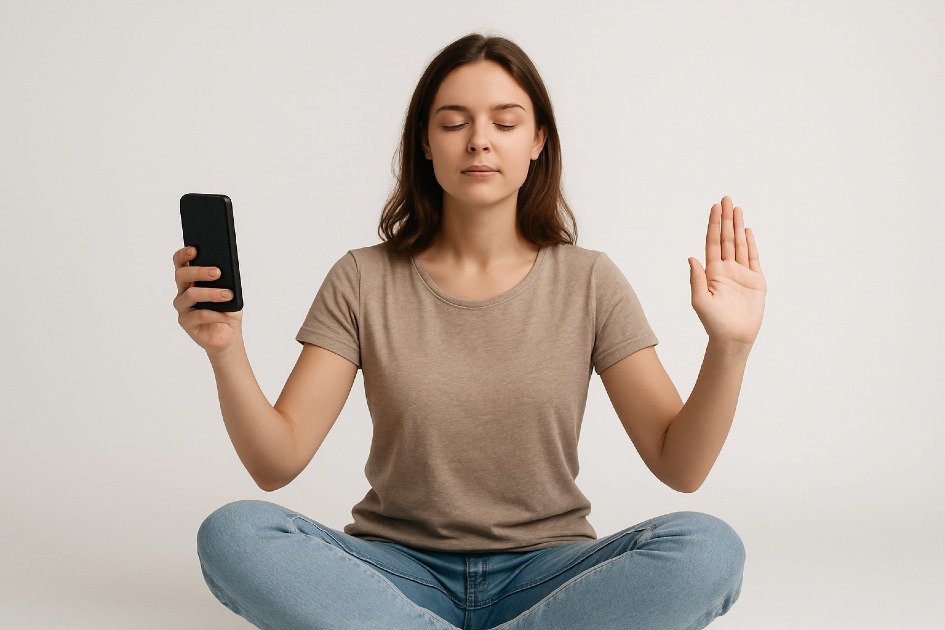
Beat Everyday Digital Detox Struggles
Digital detoxing offers liberation but presents challenges such as fear, habit, and pressure. Recognizing these issues and finding practical solutions is essential for attaining lasting mental clarity.
Dealing With FOMO and Social Pressure
Why it matters:
Fear of missing out (FOMO) can hinder digital detox efforts by causing stress through constant social media engagement.
Overcoming FOMO helps individuals appreciate real-life experiences and enhances emotional resilience.
How to do it:
- Set clear intentions before your digital detox. Know if you want better sleep, less stress, or more focus. Write it down to stay committed.
- Tell your network by sharing a quick message or post about your digital break. This eases the pressure to reply fast.
- Set check-in times by picking specific moments to see updates instead of constantly refreshing feeds.
- Enjoy reading, cooking, or walking. Being offline strengthens focus and eases social media urges.
Managing Work or School Demands While Offline
Why it matters:
Digital detoxes can improve focus and efficiency, countering the fear of unplugging due to work or school responsibilities, if approached correctly.
How to do it:
- Manage urgent tasks first: List top priorities and work on them in focused bursts before your digital detox.
- Tell colleagues or classmates when you are available. Use auto-replies to manage expectations.
- Track tasks offline with journals, planners, or calendars to stay organized without screens.
- Check emails, calls, and messages in set times to stay focused and avoid constant interruptions.
Staying Consistent and Avoiding Relapse
Why it matters:
Breaking the habit of constant device use is challenging, as inconsistency can lead to reverting to old routines and negating the benefits of a digital detox.
Maintaining discipline is crucial for achieving long-term mental clarity.
How to do it:
- Schedule daily tech-free time by picking consistent windows each day to unplug and strengthen your habit.
- Notice small wins and track progress, like cutting screen time by an hour, to stay motivated.
- Swap screen time for fun offline activities like reading, drawing, or exercising
- Partner up by telling a trusted friend or family member your goals and let them help track your progress.
Managing Emotional Triggers
Why it matters:
Devices can function as emotional crutches, where stress, boredom, or loneliness led to compulsive scrolling, making digital detoxes uncomfortable.
How to do it:
- Spot triggers by noticing when you grab your device out of habit, not need.
- Try healthier habits such as meditating, journaling, or practicing deep breathing instead of scrolling.
- Step-down detox by cutting screen time bit by bit, giving your brain time to adjust.
- Get help by joining digital wellness communities for tips and support
Rebuilding Digital Boundaries
Why it matters:
Setting intentional limits on technology is crucial to prevent the rapid return of old patterns and to ensure technology serves users effectively.
How to do it:
- Set “tech-free zones” by choosing spots in your home—like the bedroom or dining table—where no devices are allowed. It helps you relax, connect, and stay present.
- Plan check-ins by setting fixed times to check social media or emails. This helps you stay focused and avoid scrolling without thinking.
- Use tech smartly by trying apps that help you stay balanced with your devices like screen time trackers.
- Take a few minutes each week to see how much time you spend online. If screens are taking over your day, set new limits and stick to them.
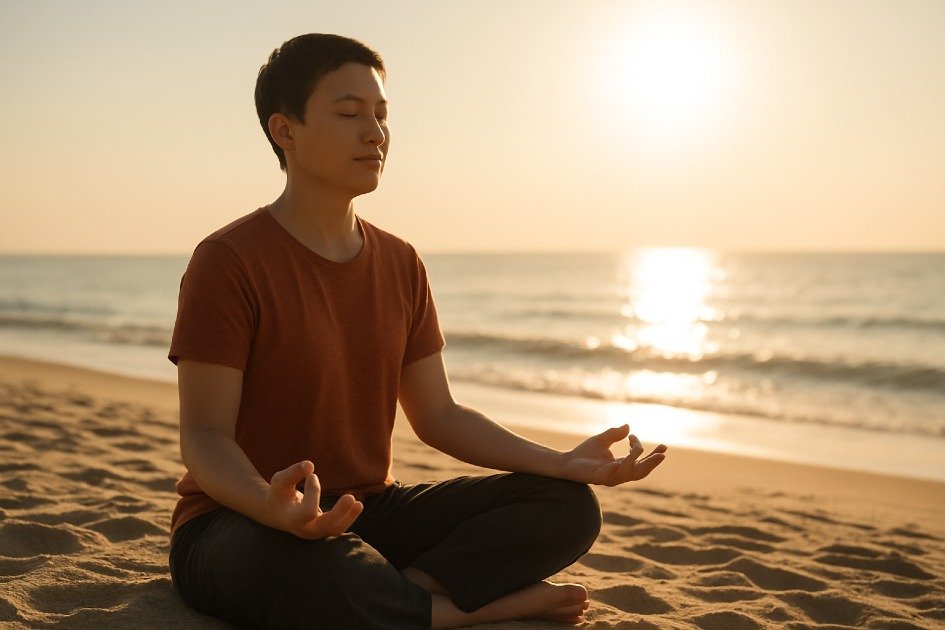
Sustaining Long-Term Mental Clarity
Maintaining long-term mental clarity involves developing habits that protect focus and well-being, rather than relying on a single digital detox.
Creating a Balanced Relationship with Technology
Why it matters:
Constant connectivity leads to chronic stress and distractions, undermining mental clarity. A balanced use of technology can mitigate digital overwhelm and enhance concentration.
How to do it:
- Check your screen time. Notice which apps consume most of your day. Spot what makes you scroll without thinking and take control of your time online.
- Create tech-free spaces by keeping phones and gadgets out of your bedroom or dinner table to protect your peace of mind.
- Set specific times to check your emails, social media, and news. This helps you stay focused and stop constant distractions.
- Be mindfully engaged before you tap any app, pause and ask, “Will this help me reach my goals or pull me off track?” Stay focused on what truly matters, not what steals your time.
I use my smartphone with apps that help me stay focused instead of distracted. These productivity tools keep my goals clear and my time on track.
Reset Your Body and Mind Regularly
Why it matters:
Periodic digital detoxes can help reset the brain, enhance sleep quality, and emphasize the importance of offline living, even as mental clutter may re-emerge over time despite improved digital habits.
How to do it:
- Choose one day each week to unplug from screens. Spend that time doing something real—read a book, enjoy a hobby, or take a walk in nature.
- Take a few days off from screens to rest your mind and recharge. Spend time in nature, journal, or simply relax.
- After each digital detox, write down how your focus, mood, and creativity changed. Seeing your progress keeps you motivated to stay consistent.
Build Mindful Offline Rituals
Why it matters:
Mental clarity is achieved through offline practices that recharge energy, enhance creativity, and alleviate stress. Intentional offline rituals are essential, as mere digital detoxes may not provide lasting benefits.
How to do it:
- Start your day with calm — try a few minutes of meditation, gentle stretches, or a short journal entry before checking your phone.
- Try reading, gardening, cooking, or doing art projects.
- Spending time in nature boosts your focus, clears your mind, and lowers stress.
- End your day with reflection or gratitude, not endless scrolling.
Reassess and Adjust Regularly
Why it matters:
Reassessing digital habits is crucial to prevent old patterns from undermining the benefits of a digital detox.
How to do it:
- Do your monthly check by tracking the screen time and spotting new problem areas.
- Set flexible boundaries by changing tech-free zones, app limits, or notifications as your routine shifts.
- Create mini goals by adding small, fresh goals to stay motivated and avoid getting stuck.
When I stick to digital detox habits, my mind stays clear and focused, letting me enjoy both online and real-life moments fully.
Recap: Embrace the Freedom of a Clear Mind
Embracing a digital detox means stepping back from screens to regain mental clarity and creativity. Even small actions, such as limiting screen time at night, can produce significant improvements.
A study of 1,026 UK employees reported by The US Guardian indicates that 75% experienced reduced burnout and stress when working from home part-time, underscoring the advantages of disconnecting from digital devices.
This process allows individuals to reclaim their focus and reduce stress, leading to a more manageable daily life and enriched conversations.
According to the US Bureau of Labor Statistics, offline work can significantly boost productivity by minimizing digital distractions and enhancing focus. Research indicates that constant task-switching from digital interruptions can reduce productivity by as much as 40%.
By practicing regular digital detoxes, one fosters a sustainable rhythm that enhances mental health and emotional well-being.
Ultimately, a digital detox transforms both daily routines and attitudes towards technology, promoting a sense of serenity and vibrant living.
Frequently Asked Questions
How long should a digital detox last?
The duration of digital detox varies based on individual lifestyle and digital engagement. Beginners might start with a 24-hour mini-detox, while those desiring deeper mental clarity could pursue week-long or longer retreats.
The aim is to establish a timeframe that is realistically achievable yet challenging. Utilizing digital wellness apps can assist in tracking progress and transitioning to more extended detox periods.
Can digital detox improve sleep and productivity?
Reducing screen time, particularly before bedtime, decreases blue light exposure, which can disrupt circadian rhythms and melatonin production.
Individuals who engage in a digital detox often experience better sleep quality, heightened focus, and enhanced problem-solving skills.
Combining this detox with sleep optimization tools can further enhance these benefits, fostering a routine that boosts mental clarity and productivity.
What are quick digital detox tips for busy schedules?
Even with a busy schedule, you can take quick digital detox breaks:
- Micro-breaks: Take a 5-minute movement break every 90 minutes away from screens.
- Morning rituals: Start your morning with meditation, journaling, or stretching before checking your apps.
- Notification triage: Turn off unnecessary alerts to clear your mind and stay focused.
Incorporating gradual habits can prevent burnout and create a lasting digital detox routine without hindering workflow, supported by time management tools.
How do I manage social media addiction during a detox?
Social media can initiate a cycle of dopamine release, complicating the process of detoxification. Start by:
- Utilizing digital wellbeing systems to establish usage limitations for apps.
- Using offline pastimes like reading, gardening, or sketching in place of scrolling.
- Social encounters that take place offline, free from digital intrusion, fulfill connection demands.
Can children benefit from digital detox strategies?
Yes, using age-appropriate digital detox techniques can help kids develop their social skills, emotional control, and cognitive abilities. Techniques include:
- Establish family mealtimes or outdoor activities that are tech-free.
- Promoting inventive games, crafts, and other forms of creative offline play.
- To prevent resistance, set screen restrictions gradually rather than completely.
How often should I practice digital detoxing?
Intensity is not as crucial as consistency. Many experts recommend:
- Weekly mini-detoxes, such as Sundays without screens.
- Extended digital detox days are held once a month to reset mental clarity and attention spans.
- Immersion vacations from digital overload are offered via seasonal retreats.
Are there risks of going completely offline?
Short-term digital detoxes are safe for most people. However, lengthy periods of complete disconnection may:
- Interrupt important work-related conversations.
- Cause anxiety in people who rely heavily on internet connectivity.
What are the best offline activities for mental clarity?
During a digital detox, mental, physical, and sensory activities improve clarity. Examples include:
- Forest bathing or mindful wandering.
- Journaling or writing with reflection.
- Artistic endeavors like cooking, painting, or music.
Regularly incorporating these activities helps people become more resilient to digital overstimulation.
How do I track progress without using digital tools?
Even during a digital detox, you can manually monitor your progress:
- Keep a notebook to record shifts in your energy, focus, and mood.
- Record your productivity levels and sleep habits.
- Every week, consider how you might improve your mental clarity and reduce stress.
Can digital detox techniques be incorporated into work life?
It is possible to establish digital boundaries at work without sacrificing output:
- Set aside particular times to check your messages and emails.
- To improve focus when working deeply, use offline blocks.
- Promote digital wellness programs for the entire team to increase productivity.

